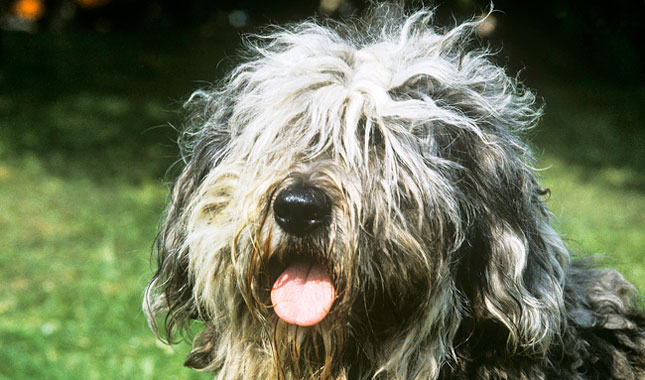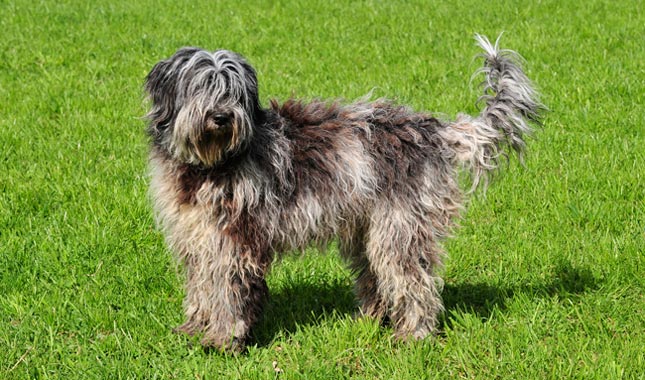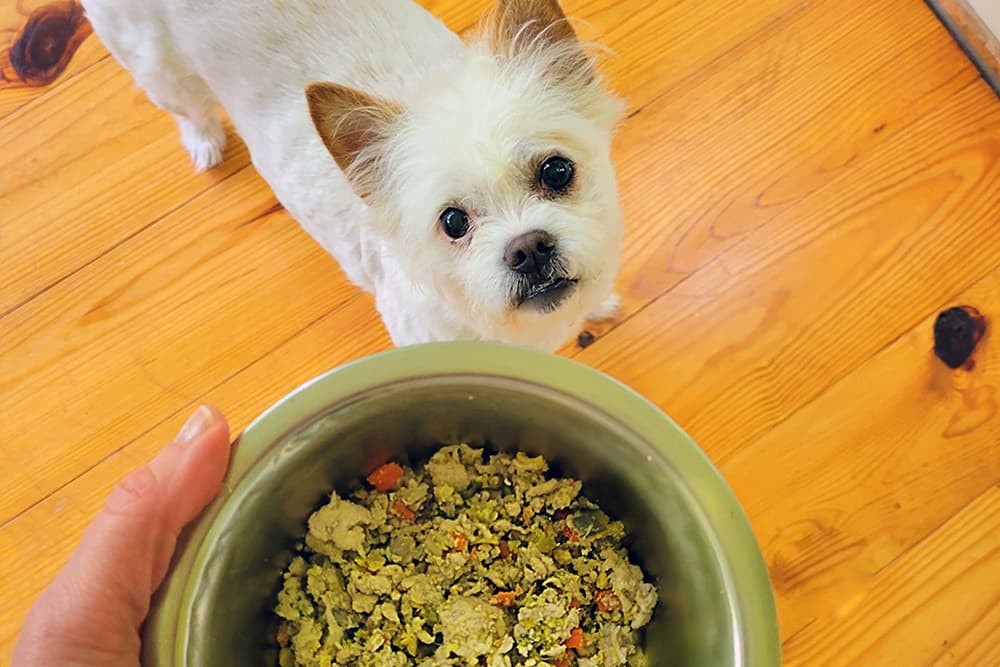Bergamasco
Published on July 05, 2011
Breed Details
- Height: 22 to 23.5 inches at the shoulder
- Weight: 55 to 85 pounds
Breed Characteristics
Adaptability
Trainability
Grooming
Apartament Friendly
Child Friendly
Shedding Level
Dog Friendly
Exercise Needs
Territorial
Barking Tendencies
Health Issues
Social Needs
Energy Level
Affectionate
Watchdog Instincts
Cat Friendly
Intelligence
Stranger Friendly
The Italian Bergamasco is a large sheepdog with a corded or matted coat that comes in all shades of gray. These days, the Bergamasco is primarily a family companion or show dog, though some still have a strong herding instinct.
Patient and quiet, this ancient Italian sheepherder is protective and makes an excellent watchdog. He is not aggressive, but is alert and watches strangers keenly. His work ethic is second to none.
The Bergamasco has been bred to think for himself and is more of a working partner than a subordinate. He is intelligent enough to problem-solve, which may or may not be a positive characteristic, depending on what he decides to do.
The result is a patient, self-sufficient dog who has a deep connection with people. The Bergamasco has a particular affinity for children and appoints himself as their watcher. He is also an ideal dog for therapy visits to children who are in the hospital or have disabilities.
The Bergamasco is gentle with his family, and, in the absence of a flock, his primary job is to protect them. He is alert, always ready to bark an alarm or to step in and protect if he feels it’s necessary. These are great qualities, but it’s essential to teach him from puppyhood when it’s okay to exercise his protective nature and when to let you take charge. Early socialization and training are a necessary part of his upbringing to prevent him from becoming overly suspicious or fearful of anything new or different.
If you want a dog that will always obey you without question, the Bergamasco is probably not the right choice. He will respond to kind, firm, consistent training, but he can be independent and self-sufficient.
The Bergamasco will accept strangers once he has been introduced to them. If raised together, he gets along well with other pets.
Give this breed daily exercise in the form of a moderate to long walk or active play time. He can be a good competitor in dog sports such as agility, obedience, and rally and is a natural at hiking in the mountains.
While you might think of him as an outdoor dog, nothing could be farther from the truth. Bergamascos are devoted to their people. They should have access to a securely fenced yard, but when the family is home, the Bergamasco should be with them.
Other Quick Facts
- When you look at a Bergamasco, you will see a muscular dog with a large head whose slightly rectangular body is covered in a thickly matted coat made up of three types of hair. The hair on the head hangs over his large oval brown eyes, and he has a calm, attentive expression. His thick tail hangs down, curving slightly upward at the end.
- The Bergamasco’s coat comes in shades of gray and, rarely, solid black.
The History of the Bergamasco
This is an Italian sheepherding breed who takes his name from his hometown, Bergamo (although he is also known in other parts of the country). He is similar to other central European sheepdog breeds, including the Puli which shares his heavily matted coat.
After World War II, the Bergamasco was in danger of disappearing because there was less work for herding dogs. Fortunately, an Italian breeder, Dr. Maria Andreoli, stepped in and led the effort to save the breed.
The Bergamasco has not yet achieved full recognition from the American Kennel Club but is biding his time in the Miscellaneous Class.
Bergamasco Temperament and Personality
The Bergamasco could be described as an attentive, intelligent, patient, do-it-yourselfer. His heritage as a shepherding breed causes him to think and act for himself. He is an excellent companion and devoted to his family, especially children, but rest assured he has his own ideas on just about everything. He is a courageous guard, with a strong protective instinct, but is never aggressive. The Bergamasco is a good breed choice for a person who appreciates his self-sufficiency and ability to solve problems.
Bergamascos respond well to consistent positive training. A light hand is all that’s needed for this smart breed. The Bergamasco is very good at sussing people and situations out. He will look to you as a friend and for guidance, but probably won’t follow you with blind obedience. His breed standard describes him as “naturally stubborn” but in a good way —persevering until a task is done.
The Bergamasco is highly athletic, so plenty of exercise is important for his physical and mental health. He also requires a lot of space for activity and is not a good choice for apartment or condo living.
Start training your puppy the day you bring him home. Even at eight weeks old, he is capable of soaking up everything you can teach him. Don’t wait until he is 6 months old to begin training or you will have a more headstrong dog to deal with. If possible, get him into puppy kindergarten class by the time he is 10 to 12 weeks old, and socialize, socialize, socialize. However, be aware that many puppy training classes require certain vaccines (like kennel cough) to be up to date, and many veterinarians recommend limited exposure to other dogs and public places until puppy vaccines (including rabies, distemper and parvovirus) have been completed. In lieu of formal training, you can begin training your puppy at home and socializing him among family and friends until puppy vaccines are completed.
Speak with a reputable, experienced Bergamasco breeder. Describe exactly what you’re looking for in a dog, and ask for assistance in selecting a puppy. Breeders see the puppies daily and can make uncannily accurate recommendations once they know about your lifestyle and personality. Choose a puppy whose parents have approachable personalities and who has been well socialized by the breeder from birth.
What You Need To Know About Bergamasco Health
All dogs have the potential to develop genetic health problems, just as all people have the potential to inherit diseases. Run from any breeder who does not offer a health guarantee on puppies, who tells you that the breed is 100 percent healthy, or who keeps puppies isolated from the main part of the household for health reasons. A reputable breeder will be honest and open about health problems in the breed and the frequency with which they occur.
That said, Bergamascos have a reputation for being healthy. No specific diseases are known to be associated with them, but the Bergamasco Sheepdog Club of America says breeders should obtain hip clearances on dogs before breeding them. Because they are so rare, popularity and overbreeding have yet to take a toll on their health, but it’s a good idea to ask breeders about the incidence of hip dysplasia, eye problems and gastric torsion.
Remember that after you’ve taken a new puppy into your home, you have the power to protect him from one of the most common health problems: obesity. Keeping a Bergamasco at an appropriate weight is one of the easiest ways to extend his life. Make the most of your preventive abilities to help ensure a healthier dog for life.
The Basics of Bergamasco Grooming
The Bergamasco’s coat is unusual in having three different types of hair in it (referred to as dog hair, goat hair, and wool) that weld together and felt into mats. After five or six years, the coat reaches the ground. Some of the hair acts like the visor on a baseball cap to protect his eyes from the sun, but he can see past it. That coat helps protect the Bergamasco against everything from wolf bites to mosquitoes. Most people with dog allergies do not react to the Bergamasco’s coat, but some who are allergic to wool or lanolin do react.
The coat is much easier to care for than you’d think, but when wet it can take on the odor of a wet wool sweater (don’t say you weren’t warned!). The flocking doesn’t extend to the skin, so it doesn’t cause skin irritation.
Caring for the Bergamasco’s coat is not necessarily difficult, but it does call for some specific approaches. Ask the breeder to show you how to care for the coat. Trim the hair around the mouth and clean the dog’s face after meals to help reduce the odor.
A common misconception is that the coat should not be brushed, but once the coat is formed, nothing will change it. Brushing is necessary to remove dirt.
The Bergamasco can have as many baths as other dogs, but shampoo is not recommended because it dissolves natural oils in the coat.
The rest is basic care. Trim the nails as needed, usually every few weeks. Keep the ears clean and dry to prevent bacterial and yeast infections. Brush the teeth frequently with a vet-approved pet toothpaste for overall health and fresh breath.
Finding a Bergamasco
Whether you want to go with a breeder or get your dog from a shelter or rescue, here are some things to keep in mind.
Choosing a Bergamasco Breeder
Finding a quality breeder is the key to finding the right puppy. A good breeder will match you with the right puppy and will have completed all the health certifications necessary to screen out health problems. She is more interested in placing pups in the right homes than making big bucks.
Good breeders will welcome your questions about temperament, health clearances, and what the dogs are like to live with. They will come back at you with questions of their own about what you’re looking for in a dog and what kind of life you plan to provide. A good breeder can tell you about the history of the breed, explain why one puppy is considered pet quality while another is not, and discuss what health problems affect the breed. Remember, breeders who offer puppies at one price “with papers” and at a lower price “without papers” are unethical.
Look for more information about the Bergamasco and start your search for a good breeder at the website of the Bergamasco Sheepdog Club of America and the International Bergamasco Sheepdog Association. Choose a breeder who has agreed to abide by the BSCA’s code of ethics, which prohibits the sale of puppies to or through pet stores and calls for the breeder to obtain recommended health clearances on dogs before breeding them.
Avoid breeders who seem interested only in how quickly they can unload a puppy or whether your credit card will clear. You should also bear in mind that buying a puppy from websites that offer to ship your dog to you immediately can be a risky venture, as it leaves you no recourse if what you get isn’t exactly what you expected. Put at least as much effort into researching your puppy as you would into choosing a new car or expensive appliance. It will save you money in the long run.
Lots of reputable breeders have websites, so how can you tell who’s good and who’s not? Red flags include an over-availability of puppies, multiple litters on the premises, a choice of any puppy, and the ability to pay online with a credit card. Quickie online purchases are convenient, but they are almost never associated with reputable breeders.
Whether you’re planning to get your new best friend from a breeder, a pet store, or another source, don’t forget that old adage “let the buyer beware”. Disreputable breeders and facilities that deal with puppy mills can be hard to distinguish from reliable operations. There’s no 100% guaranteed way to make sure you’ll never purchase a sick puppy, but researching the breed (so you know what to expect), checking out the facility (to identify unhealthy conditions or sick animals), and asking the right questions can reduce the chances of heading into a disastrous situation. And don’t forget to ask your veterinarian, who can often refer you to a reputable breeder, breed rescue organization, or other reliable source for healthy puppies.
The cost of a Bergamasco puppy varies depending on the breeder’s locale, whether the pup is male or female, what titles his parents have, and whether he is best suited for the show ring or a pet home. The puppy you buy should have been raised in a clean home environment, from parents with health clearances and conformation (show). Ideally, you should see working titles to prove that they are good specimens of the breed. Puppies should be temperament tested, vetted, dewormed, and socialized to give them a healthy, confident start in life.
Before you decide to buy a puppy, consider whether an adult Bergamasco might better suit your needs and lifestyle. Puppies are loads of fun, but they require a lot of time and effort. An adult Bergamasco may already have some training and will probably be less active, destructive, and demanding than a puppy. With an adult, you know more about what you’re getting in terms of personality and health and you can find adults through breeders or shelters. If you are interested in acquiring an older dog through breeders, ask them about purchasing a retired show dog or if they know of an adult dog who needs a new home. If you want to adopt a dog, read the advice below on how to do that.
Adopting a Dog From a Bergamasco Rescue or Shelter
There are many great options available if you want to adopt a dog from an animal shelter or breed rescue organization. Here is how to get started.
1. Use the Web
Sites like Petfinder.com can have you searching for a Bergamasco in your area in no time flat. The site allows you to be very specific in your requests (housetraining status, for example) or very general (all the Bergamasco s available on Petfinder across the country). AnimalShelter can help you find animal rescue groups in your area. Also some local newspapers have “pets looking for homes” sections you can review.
Social media is another great way to find a dog. Post on your Facebook page that you are looking for a specific breed so that your entire community can be your eyes and ears.
2. Reach Out to Local Experts
Start talking with all the pet pros in your area about your desire for a Bergamasco. That includes vets, dog walkers, and groomers. When someone has to make the tough decision to give up a dog, that person will often ask her own trusted network for recommendations.
3. Talk to Breed Rescue
Most people who love Bergamascos love all Bergamascos. That’s why breed clubs have rescue organizations devoted to taking care of homeless dogs. The Bergamasco Sheepdog Club of America can help you find a dog that may be the perfect companion for your family. You can also search online for other Bergamasco rescues in your area.
The great thing about breed rescue groups is that they tend to be very upfront about any health conditions the dogs may have and are a valuable resource for advice. They also often offer fostering opportunities so, with training, you could bring a Bergamasco home for a trial to see what the experience is like.
4. Key Questions to Ask
You now know the things to discuss with a breeder, but there are also questions you should discuss with shelter or rescue group staff or volunteers before you bring home a pup. These include:
What is his energy level?
How is he around other animals?
How does he respond to shelter workers, visitors and children?
What is his personality like?
What is his age?
Is he housetrained?
Has he ever bitten or hurt anyone that they know of?
Are there any known health issues?
Wherever you acquire your Bergamasco, make sure you have a good contract with the seller, shelter, or rescue group that spells out responsibilities on both sides. Petfinder offers an Adopters Bill of Rights that helps you understand what you can consider normal and appropriate when you get a dog from a shelter. In states with “puppy lemon laws,” be sure you and the person you get the dog from both understand your rights and recourses.
Puppy or adult, a breeder purchase or a rescue, take your Bergamasco to your veterinarian soon after adoption. Your veterinarian will be able to spot problems and will work with you to set up a preventive regimen that will help you avoid many health issues.










